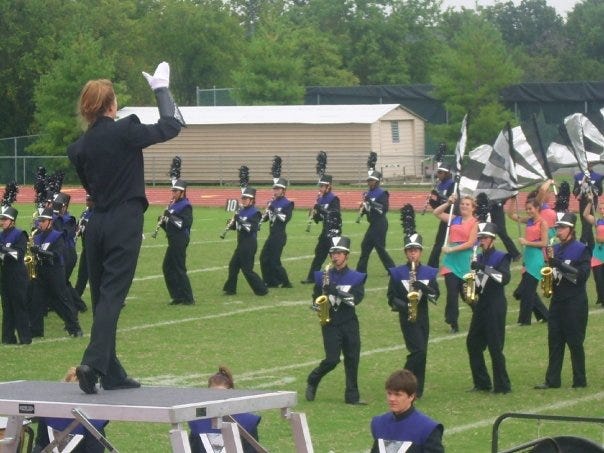Dissertation Tuesdays: Introduction
What does high school marching band, and our relationship with time, have to do with consumer culture?
Every Tuesday I post a short excerpt from my dissertation which explores the phenomenon of social acceleration and consumer culture (available in full here).
When I was in high school— a defining moment for many American teenagers— I was in the marching band. That meant that on any given Friday and Saturday in the Fall, you would find me in a full wool suit adorned with sequins, a feather plume atop my head, roll stepping my way in formations across a football field in a manner that I perceived to be musical and artistic expression in the finest form. My last two years of marching band, I served as drum major, the conductor of the ensemble.
The drum major is essentially a glorified metronome. A time-keeping device. A continuously ticking, visual reminder to stay “in time” with everyone else. It was my job to make sure that everyone was at the correct tempo.
One of the most crucial and challenging tasks of being drum major was to visually communicate this correct tempo to band members spread over 40,000 square feet. (When modern scholars discuss the realities of time-space compression and expansion, I always wonder if they have experience conducting a high school marching band…)
For me, this entailed a series of elaborate, exaggerated hand motions while standing atop a 6-foot podium on the fifty-yard line. Meanwhile on the field, each individual person had their own interpretations of tempo: when to hit the downbeat of the next measure, the cadence of each step, the timing of the next sixteenth-note run, and most importantly, the unified pause of the all-exquisite “rest”. Everyone was—ahem—marching to their own beat.
It was during this experience that I learned that in music and in life, there tends to be contradictions between the “correct” tempo and the internalized tempo. And in many ways, the drum major is much like the norms of our culture, working fervently to keep everyone—from the tubas to the snare drums—in line.
Somehow, I strayed from musical passion into educational endeavors and a career focusing on economics, marketing, and sociology. But I would never forget how frustrating it was to try to “keep tempo” in a world of many different temporal expressions. Time, rhythm, and cadence remained in my consciousness. So, when I began the Ph.D. program in marketing, it was natural to combine several of my past life experiences to consider the phenomenon of temporality in the context of the market environment.
This brings me to my dissertation, which boldly begins by stating:
Consumer culture is fast. Goods, services, people, ideas, and values – the material and nonmaterial aspects of culture – are moving more quickly throughout the marketing system than ever before. Such acceleration affects diverse stakeholders: people, public, and planet. This project explores the phenomenon of ‘social acceleration’, and specifically, the ‘acceleration of the pace of life’ which examines the feeling that time is going faster in modern societies as a result of “the increase of action episodes per unit of time” (Rosa 2013, 80).
This project develops an understanding of how meanings in marketing are socially constructed in relation to this phenomenon, focusing on the following research question: "How do consumers experience and personalize the cultural meanings of social acceleration in their everyday life?” This question requires an examination of the phenomenon from both a macro (cultural meaning) and micro (individual experience and personalization) perspective in order to create a palatable understanding.




